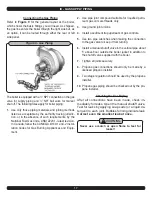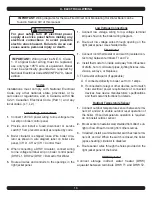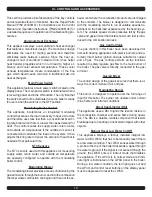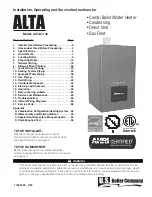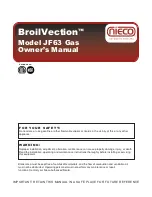
4
Iv - BOILER RaTINGS aND CaPaCITIES
TaBLE 1: SEa LEvEL RaTINGS - NaTURaL aND PROPaNE GaSES
Boiler Input Rate
(mBh)
(1)
heating Capacity
(mBh)
(1)(2)
Net I=B=R Rating (mBh)
(1)
afUE
(2)
flue Diameter
Shipping
wt.
high fire
200
190
165
95%
2” CPVC & 3” PVC
284 lbs.
Low fire
80
76
66
(1)
1 MBH = 1,000 Btuh (British Thermal Units Per Hour)
(2)
Heating Capacity and AFUE (Annual Fuel Utilization Efficiency) are based on DOE (Department of Energy) test procedures.
TaBLE 2: 95m-200 hIGh aLTITUDE DERaTE ChaRT
Boiler Input
Rate (mBh)
altitude (In feet)
3,000 (2) 4,000 (2) 5,000 (3)
6,000
7,000
8,000
9,000
10,000
high fire
196
192
177
174.5
172
169
168
167
Low fire
78.4
76.8
115
113.5
112
110
109
108
1) b
oiler Input Rate is determined at minimum vent length. The rate will decrease as vent length increases.
2) Parameter 17 is set to 2,250 at elevations of 2,000 feet above and below.
3) Parameter 17 must be raised to 3,200 at altitudes or elevations of 2,000 feet and above.
These low pressure gas-fired hot water boilers are de-
sign certified by CSA International, for use with natural
and propane gases. The boilers are constructed and hy-
drostatically tested for a maximum working pressure of
50 PSIG (pounds per square inch gauge) in accordance
with ASME (American Society of Mechanical Engineers)
Boiler and Pressure Vessel Code Section IV Standards
for heating boilers.
The Boilers are certified in accordance with ANSI (Ameri-
can National Standards Institute) Z21.13 standards as
gas-fired, direct vent, condensing, hot water boilers.
The Heating Capacity indicates the amount of heat avail-
able after subtracting the losses up the stack. Most of this
heat is available to heat water. A small portion is heat loss
from the jacket and surfaces of the boiler, and it is as-
sumed that this heat stays in the structure. The Net I=B=R
Rating represents the portion of the remaining heat that
can be applied to heat the radiation or terminal units (i.e.,
finned tube baseboard, cast iron radiators, radiant floor,
etc.) The difference between the Heating Capacity and
the Net I=B=R Rating, called the piping and pickup allow-
ance, establishes a reserve for heating the volume of wa-
ter in the system and offsetting heat losses from the pip-
ing. The Net I=B=R Ratings shown are based on a piping
and pickup factor of 1.15 in accordance with the I=B=R
Standard as published by the Hydronics Institute. The Net
I=B=R Rating of the boiler selected should be greater than
or equal to the calculated peak heating load (heat loss) for
the building or area(s) served by the boiler and associated
hot water heating systems. The manufacturer should be
consulted before selecting a boiler for installations having
unusual piping and pickup requirements.
This boiler and related hot water heating sys-
10.
tems are not do-it-yourself items. They must be
installed and serviced by qualified profession-
als. Ratings above are for sea level applications.
The boiler automatically derates input at a rate
of 2% for every 1000 feet above an elevation
of 2000 feet (see Table 2). The boiler will also
derate relative to the calorific value of the gas
being used. Use the formula specified in “Mea-
sure The Natural Gas Input Rate” in Section VII
of the Control Manual and Operating Instructions
(P/N# 240006104) to determine the proper rate
due to derated gas. To ensure proper operation
at 5,000 feet of altitude and above, the minimum
RPM setting; parameter 17, must be raised to
3,200. Instructions on how to change the param-
eters are included in the Parameter Guide, part
number 240006105.

















